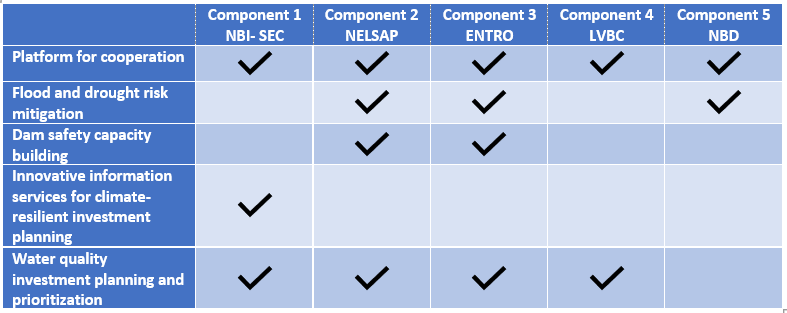Project Description
Joint decisions taken by Nile Basin officials on matters relating to water resources management and development are the primary way in which countries signal their interest in the utilisation of cooperative mechanisms. The fact that countries involved in the decision commit and agree to deepen their cooperation on that topic signifies an inherent improvement in that cooperative mechanism. Decisions captured under this indicator must be related to project activities and must result from cooperative outcomes, such as capacity and inclusion strategies approved, frameworks and policies approved related to dam safety and flood early warning, and investment roadmaps and prioritisation improved. See Annex 9 for more details on the joint decisions expected to be reached as a result of project activities.
Percentage of users of mechanisms for cooperation on water resources management and development, who rate them as “satisfactory” or higher.
The mechanisms for cooperation, defined above, are the primary services that regional organisations such as the NBI, NBD and LVBC provide to users to establish trust, underpin decision-making, and inform investment. Stakeholders’ perception of these mechanisms in terms of utility and relevance to the Basin’s cooperation needs will be assessed using user surveys that rate these mechanisms. An improvement in the mechanism is demonstrated by increasing satisfaction of the users. “Users” are people that participate in direct use of or in a capacity-building session on specific tools, data or analyses and/or people that participate in directly facilitated dialogues. Results will be interpretable as they are aggregated over time.
TAC and COM decisions will be the primary source of data for this indicator, constituting agreement among senior technical officials (TAC) and ministers with responsibilities for water resources (COM).
Project Development Objective (PDO) Statement
The project development objective is to improve mechanisms for cooperation on water resources management and development in the Nile Basin. For the purposes of the Project’s PDO the following definitions apply:
- Mechanisms for cooperation are the tools, data, analyses, or processes to facilitate and inform regional cooperation on water resources management and development issues. These include tools and processes related to hydromet services; water quality data collection; climate resilient planning; flood and drought monitoring; and processes for investment identification; water quality investment planning; water allocation tradeoff; irrigation modernisation; dam safety, information services, and policy guidance.
- Water resources management and development are the processes of planning, developing, and managing water resources, in terms of both water quantity and quality, across all water uses. It includes the institutions, infrastructure, incentives, and information systems that support and guide climate resilient water management. Water management and development are inherently linked and are therefore defined together as one term.
Thematic Areas
- Thematic Area 1: Platform for cooperation
- Thematic Area 2: Flood and drought risk mitigation
- Thematic Area 3: Dam safety capacity building
- Thematic Area 4: Innovative information services for climate-resilient investment planning
- Thematic Area 5: Water quality investment planning and prioritisation
Support for these Thematic Areas is organised into five project components that are organised according to five implementing agencies to simplify fiduciary and operational elements of the Project. The proposed activities implemented by each centre are prioritised based on the agencies’ mandates and strengths as well as anticipated opportunities for cooperation to facilitate water resources management and development in the basin or designated sub-basin. The Thematic Areas covered by each component (implementing agency) is summarised in the table.

- NBI Capacity Building Strategy approved
- NBI Media Strategy approved
- NBI Gender Mainstreaming Strategy approved
- Risk Management Framework for Dam Safety approved
- Basin-wide dam safety regulatory framework approved
- Dam safety training center implementation plan approved
- Drought early warning system approved
- Flood mitigation investment roadmap approved
- Flash flood early warning system approved
- Water Quality Hotspot investment prioritisation methodology approved
- Four water quality hotspots selected for investment planning and prioritisation
- Draft regional policy harmonising water quality management approved
